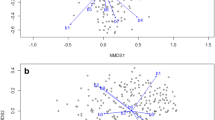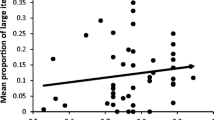Abstract
Nesting behavior was found to differ for animals of five different inbred strains ofMus musculus reared in the same environment, indicating heritable differences in level of nesting byMus. For two separate crosses, hybrid animals built larger nests than did animals of the inbred parental strains. In addition, from data of one of the crosses and derived generations, a very low heritability of nesting but substantial dominance variance were found. This pattern of results is expected of characters which have been the target of natural selection. MaleMus were found to build larger nests than females of all groups tested. These findings suggest that nesting byMus musculus represents required thermoregulatory behavior.
Similar content being viewed by others
References
Cottle, W. H. and Carlson, L. D. (1965). Regulation of heat production in cold-adapted rats.Proc. Soc. Exptl. Biol. Med. 92: 845.
DeFries, J. C., and Hegmann, J. P. (1970). Genetic analysis of open-field behavior. In Lindzey, G., and Thiessen, D. D. (eds.),Contributions to Behavior-Genetic Analysis: The Mouse as a Prototype, Appleton-Century-Crofts, New York, pp. 23–56.
Denenburg, V., Taylor, R., and Zarrow, M. (1969). Maternal behavior in the rat: An investigation and qualification of nest-building.Behaviour 34: 1–16.
Falconer, D. S. (1960).Introduction to Quantitative Genetics, The Ronald Press Co., New York.
Hart, J. S. (1957). Climatic and temperature induced changes in the energetics of homeotherms.Rev. Can. Biol. 16: 133.
Kinder, E. F. (1927). A study of the nest-building activity of the albino rat.J. Exptl. Zool. 57: 117–161.
King, J. A., Maas, D., and Weisman, R. G. (1964). Geographic variation in nest size among species ofPeromyscus.Evolution 18: 230–234.
Layne, J. N. (1969). Nest-building behavior in three species of deer-mice,Peromyscus. Behaviour 35: 283.
Lisk, R. D., Pretlow, R. A., III, and Friedman, S. M. (1969). Hormonal stimulation necessary for elicitation of maternal nest-building in the mouse.Anim. Behav. 17: 730–737.
Mather, K. (1949).Biometrical Genetics, Dover Publications, New York.
Rasmuson, M. (1961).Genetics on the Population Level, Svenska Bokforlaget, Bonniers, Sweden.
Roberts, R. C. (1967). Some evolutionary implications of behavior.Can. J. Genet. Cytol. 9: 419–435.
Robertson, A. (1955). Selection in animals: Synthesis.Cold Spring Harbor Symp. Quant. Biol. 20: 225–229.
Rust, C. C. (1962). Temperature as a modifying factor in the spring pelage change of shorttailed weasels.J. Mammal. 43: 323–328.
Scholander, P. F. (1955). Evolution of climatic adaptation in homeotherms.Evolution 9: 15–26.
Sealander, J. A. (1952). The relationship of nest protection and huddling to survival ofPeromyscus at low temperature.Ecology 33: 63–71.
Whitney, G., McClearn, G. E., and DeFries, J. C. (1970). Heritability of alcohol preference in laboratory mice and rats.J. Hered. 61: 165–169.
Author information
Authors and Affiliations
Additional information
This research was supported by NSF grant GU 2591 and HEW grant NS 09536.
Rights and permissions
About this article
Cite this article
Lynch, C.B., Hegmann, J.P. Genetic differences influencing behavioral temperature regulation in small mammals. I. Nesting byMus musculus . Behav Genet 2, 43–53 (1972). https://doi.org/10.1007/BF01066733
Received:
Issue Date:
DOI: https://doi.org/10.1007/BF01066733




